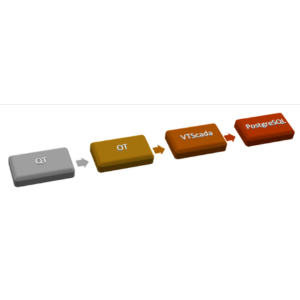IT’S ALL ABOUT THE DATA and CONSOLIDATING YOUR DATA INTO AN ENTEPRISE HISTORIAN
If you are an existing or future Trihedral customer and using VTScada, then you can have a real time enterprise historian. You can have a highly customizable PostgreSQL enterprise historian.
The VTScada BI Solution real time streams what ever data you want from your System and Alarm Historian, so it is ready for use by all current BI solutions and existing application and data integration interfaces.
Data enables workflows, workflows lead to operational excellence! The QT OT VTScada Business Intelligence (BI) solution increases operational efficiency, by using ALL your field operational data, in real time, and making it available to all people and systems in your company; all in a cost-effective manner.
[1] Create an OT Data Warehouse, a centralized, single source of truth, receiving real time streaming VTScada historian data.
Historians are full of valuable TIME SERIES data points, usually millions, sometimes billions!
These tags often lack context, requiring significant extra work to make sense of them. When your clients ask for new use cases, is it really necessary to build a custom report and do custom configuration each time? No, you can stop doing that!
Why not use the QT OT VTScada BI Solution and create an OT DATA WAREHOUSE using PostgreSQL, a robust data management system with FREE licensing?
Once you begin to consolidate and centralize all your data into your OT Data Warehouse, you can:
- consolidate additional data sets with your VTScada historian data. Integrate data from internal systems, external systems, or third-party automation cloud solutions
- provide you clients access to all this operational and engineering data via PostgreSQL, using any current BI reporting, dashboard, analytics, or machine learning tool kit
- use the VTScada ODBC Manager solution to “read and write” data to your PostgreSQL OT Data Warehouse via SQL commands, to provide more valuable data in and out of VTScada
You choose the tags you want to “stream” into PostgreSQL and then those tags are ready for use by BI tools such as MS Power BI, Oracle, Spotfire, Verdazo, QLIK, Sisense or Tableau or available for integration with your maintenance, volumetric balancing, field data capture, production reporting, or any optimization software.
Your clients can use their existing reporting, analytics and data modeling tools, or work with their IT and BI Teams, to use this valuable and core operational data.
[2] Make your OT Data Warehouse MEANINGFUL and EASY to use by adding an ASSET FRAMEWORK and META DATA.
Once you have your desired tags, thousands or millions of them, streaming into Postgres, you can easily and quickly access them, but you need to put some context, a framework, or hierarchy around each tag. We help clients add an ASSET FRAMEWORK or “equipment and facility hierarchy”, usually tied to the VTScada tag tree, to help put operational context around tags, and help them look like traditional operating
Then we work with clients to design, define, and create META DATA needed to add more context to tags, to assist in easily finding and integrating data in your OT Data Warehouse.
You could do this by adding additional properties to your VTScada tags, however meta data, especially when it grows large, should be handled by Postgres, as this meta data could apply to more than just VTScada tags, and be shared by all systems. The combination of an Asset Framework and Meta Data, makes it easy to quickly filter, find, and organize your data.
In our next article, we will review how to add even more context to your alarms and events with VTScada SMART ALARMS and SMART EVENTS.
These contextually “smart” alarms and events, essentially multi variable equations, can be used to automatically create work orders and categorize your facilities, by defining equipment and facility HEALTH STATES. Then the Health States can help you prioritize your operations, daily work, and assist in determining where to target your optimization efforts.
[3] Automated integration of data and systems is key to ELIMINATING PAPER in your operations, optimizing your operations, and saving millions in annual recurring OPEX!
Consolidating operational data, adding valuable asset framework and meta data context, and integrating this data with systems and staff, is a key leverage point, that can lead to saving thousands or millions, in annual recurring OPEX.
Eliminating paper is a key component of optimizing your daily operations.
Significant OPEX savings are easily available by automating work that does not require regular continuous human interaction. Use people on tasks that require human experience, judgement, and communication and automate repetitive administrative like tasks, which is typically achieved by eliminating paper.
[4] Provide the foundation for your client to use a Field Operational Mobile App, leveraging the OT Data Warehouse, “communicating” with VTScada.
Many recurring field operational and engineering workflows involve significant data interactions, many being field data capture exercises. Traditionally, a lot of “loose paper” and binders are involved, and when external resources, contractors, and truckers are involved, a lot of this paper can be lost, or errors discovered days after the data is captured.
Having a mobile app, that can communicate in near real time when cellular communications are available, and behave in a disconnected, “store and forward” manner, uploading updates when communications are re-established, can generate significant increases in operational efficiency.
An operational mobile app can assist in workflows such as: assisting in daily directing of facility visits, work orders, testing, and alarm management and response.
Let your field operations staff get their job done without paper, with real time feedback to and from their work planners. Direct their work through the day while providing them the information they need to get their job done, while you adapt to operational circumstances that tend to change!
Set up “operational air traffic control” across your field and direct your work each day, to get the right people, doing the right things, at the right place, at the right time”
[5] Focus on operational efficiency and using your data
VTScada includes device drivers to assure reliable polling of field data This saves you from having to deal with multiple automation protocol products, solutions, and vendors.
Easily poll your data into a VTScada Historian, and then use the QT OT VTScada BI Solution, to use and share your valuable data for operational and engineering optimization.
What are the Core Components of the VTScada BI Solution?
To implement or pilot the QT OT VTScada BI Solution, you just need to add one more licensed VTScada server, to act as the “BI Server”, which will focus on writing the tags you select, into your PostgreSQL OT Data Warehouse server. These are the two additional servers needed for the QT OT VTScada BI Solution.
How do I get a PILOT / PROOF OF CONCEPT done to verify this work for our company?
A typical QT OT VTScada BI Historian pilot is approximately three weeks of elapsed time, needs a dedicated licensed VTScada server and PostgreSQL server, and ideally a solid BI and IT resource to connect into internal existing systems and BI tools.




